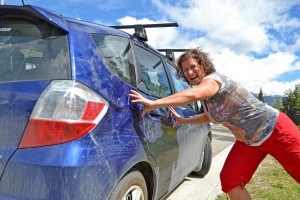
"I just remember in my rearview mirror, seeing that grizzly start running. I remember just seeing his mouth open, the teeth, the drooling."
Sylvie McKenzie, standing beside her battered car, put her hands up to two big dents in the paneling, pointing out where a charging grizzly slammed his paws June 5.
That morning, around 10 a.m., the Parks Canada employee was just a few kilometres outside of Jasper, driving down Highway 16 on her way to work at the west gate. As she was rounding a curve, she saw a male and female grizzly running on the road. Wary of their behaviour, she slowed down.
As she approached the animals, the female crossed the highway, but the male stopped. With the bears off the road, McKenzie thought it was safe to keep going. She crept by the animals at about 20 km/hr, but as she was pulling away she looked in her rearview mirror and saw the male "prancing" around.
Then, he charged.
McKenzie slammed down the gas pedal, but before she could accelerate, she felt her car shudder as the bear hit her "with full force." She heard claws scraping against the metal, and a loud slam as the bear pounded down with both its paws.
She managed to peel out, and drove about a kilometre before stopping to assess the damage. But when she got out of her car, she saw both bears still in full-tilt pursuit of her. She rushed back into her car, eventually made it clear, and called Parks dispatch to let them know what happened.
On June 9 she was in good spirits, but she remembered being terrified as the encounter unfolded.
"I was hoping he would just leave me alone, but he was like 'no, I'm in heat, I'm gonna get you,'" she said, laughing.
"I can't believe [it]—I never thought something like that would happen. I wasn't outside of my car, taking pictures or anything," she recalled, shaking her head. "I guess I was just in the wrong place at the wrong time."
McKenzie's harrowing experience was just one of several serious bear encounters that have been sending ripples of unease through the community over the past two weeks.
It started when a grizzly attacked Parks employee Etienne Cardinal while he was biking near Cottonwood Slough, May 25. Cardinal was knocked off his bike by a charging grizzly, but escaped serious injury when it bit into a can of bear spray hanging from his backpack.
Exactly a week later, a grizzly careened onto the highway near the Moberly Bridge, and a passing car had to swerve to avoid getting hit. The next day, two different cars were bluff charged by an agitated grizzly on Pyramid Lake Road when their occupants stopped to take pictures.
McKenzie's car was just one of two charged by the grizzly the morning of June 5—the second belonged to tourists on their way to Mount Robson. They found blood on their car after the bear slammed into it about an hour before it attacked McKenzie's.
Steve Malcolm is a wildlife conflict specialist for Parks Canada in Jasper. In an interview, June 9, he explained that for the past three years the grizzly presence in the valley bottom has grown significantly.
In 2011, the park saw significant snow and "everything flooded in the whole park," he said. So with less food around, a lot of bears were forced into the valley bottom to find sustenance.
"After 2011 they basically had no choice but to come to the valley bottom. Once they started to find extensive opportunities [for food] they haven't stopped showing up—they've been back every year."
Bears love the easy picking in open areas like the side of roads and along pipelines. Malcolm said the valley bottom is brimming with such opportunities, including the rail line, golf course, septic fields, roadsides, and areas that have recently been burnt as part of Parks' FireSmart efforts.
"You name it, once they start getting exposed to these type of attractants ... they will keep coming back," he said.
These days, Malcolm estimated that anywhere from 15–25 bears roam the valley in the spring, up from the three or four that used to hang around.
This year is even more unique, because for the first time a significant number of female grizzlies with cubs have also come down to the valley bottom. Usually, Malcolm explained, mothers with cubs don't hang around here, because all the male activity means their cubs are more likely to die.
With all the extra bears lurking throughout the valley, and more females piquing their interest, it makes sense that aggressive male behaviour has become more common. Getting between a male and its desired mate is incredibly dangerous, and Malcolm said most of the last two weeks' encounters are likely a result of that.
But as long as these incidents are defensive in nature—a male protecting a potential mate, or mother her cubs—Parks doesn't usually get directly involved. It's only if the events are predatory—a bear thinking a human is food—that they will destroy the animal.
And while it's been an intense couple of months for both park residents and wildlife conflict specialists, it shouldn’t last too much longer.
Malcolm explained that, normally, bears begin to head back into the mountains as the snow melts and more food becomes available. That usually happens around the end of June, and this year it looks like it will be the same.
Until then, he urged people to stay alert, pay attention to trail closures, and continue to be smart when exploring the park.
McKenzie said she's not letting her encounter keep her off the trails—she even went mountain biking the day after her car was hit.
"It's part of life, bears can be anywhere," she said, but admitted she has taken Malcolm's advice to heart.
"I do carry my bear spray now," she said.
Trevor Nichols
[email protected]
